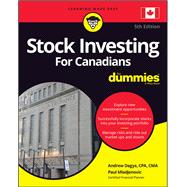Start investing in stocks today
Canada is experiencing a large housing bubble, and if you’re a Baby Boomer looking to downsize, it’s more important than ever to find a way to invest your extra money, especially in a low interest environment. Plus, some very significant tax rules exist (e.g. registered savings plans for retirement and investing, income splitting, and estate planning) that affect investors, and few Canadian publications address these new realities in the stock investing context. Canadian stock investors also have unique opportunities to invest in a recovering domestic commodity sector and a strong dividend-rich and growing financial sector.
Stock Investing For Canadians For Dummies, 5th edition arms you with trusted information on stock investing in both bear and bull markets; unique investment segments like the legal medical marijuana sector; stock investing for different types of goals, styles, and stages of life; and examples straight from the real world of stock investing as they have occurred in the past few years. With up-to-date references and resources, this fundamentally powerful yet easy-to-read book is the most reliable Canadian resource on stock market investment you can get your hands on!
- Contains 25% new and significantly revised material
- Covers the latest stock market trends including using roboadvisors, and a chapter on investing in proven digital currencies
- Provides expert tips and advice on how to navigate domestic and foreign markets including accessing surging Asian stock markets
- Helps you maximize your returns
There’s no time like the present to start investing in the stock market—and this comprehensive reference gives you all the information you need to make sure your investments grow.








